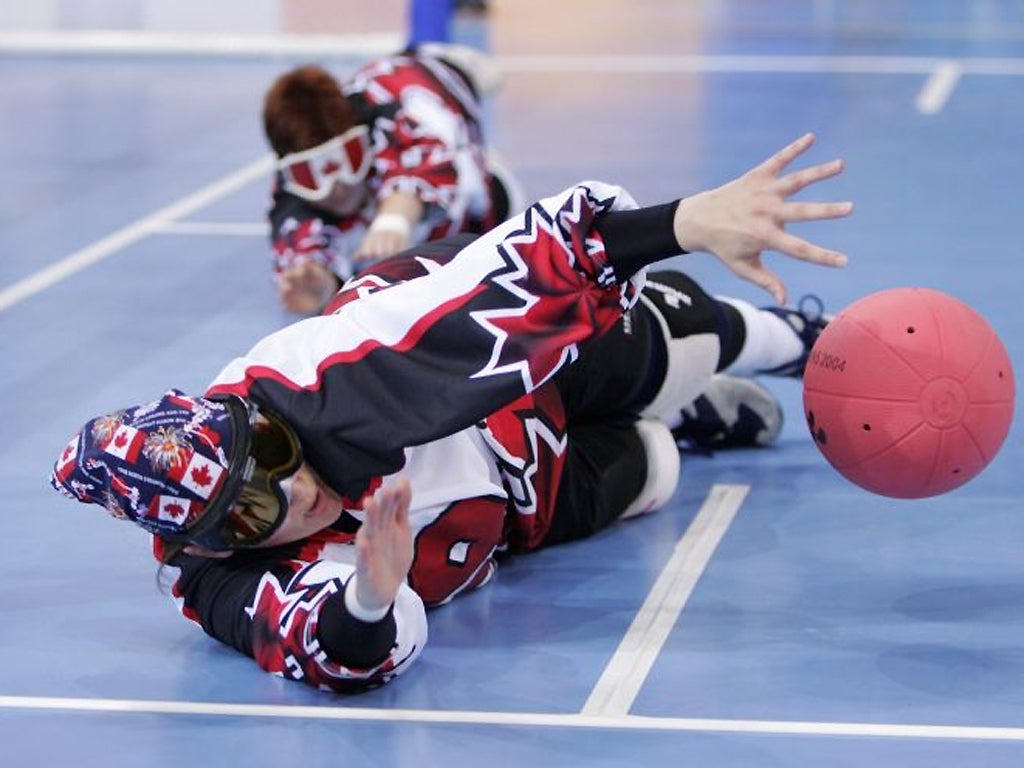Blindfolds, bells and bangs: goalball is rougher than your average sport
You don’t need good eyesight to take part in this event – which has been tailor-made for the Paralympics – but raw courage is a must, as Jerome Taylor discovers

When Jamie Hodgson was diagnosed with a degenerative eye condition and was forced to give up playing rugby league, he never thought he’d take part in a sport again. “I thought that was it,” the 27-year-old father of two from York said. “It was a difficult time. It was like my involvement in sport was over.”
But as he struggled to come to terms with the loss of both his hobby and his eyesight, his mobility worker suggested he try out goalball – a game specially developed for athletes with visual impairments. “I’d never heard of it,” Mr Hodgson recalled. “And once I’d found out what it was I thought they were nuts. But I’m so glad they persuaded me. It’s made such a difference to my life.”
Most sporting disciplines at the Paralympics are variants of Olympic sports that have been adapted. But goalball is one of three sports to be developed from scratch, for players with impairments (the others are boccia and wheelchair rugby). Its origins are in the aftermath of the Second World War, when physicians tried to find ways to rehabilitate thousands of servicemen who had been blinded on the battlefield, creating a sport that those with no vision at all could play.
Six decades on and goalball is one of the most inventive and fascinating sports on offer at the Paralympics. Two teams of three blindfolded players face off against each other on a pitch about the same size as a basketball court. They use a large ball, filled with two bells, and hurl it at the opposing team. Using nothing but their speed and ability to “see” the ball with their ears, the players have to dive in front of the ball to stop it reaching a back net. The best servers try to make the ball travel as silently as possible. All players wear dark glasses, allowing those with limited vision to compete alongside those with none. Players find their way around the court by feeling for tactile lines.
“It is not a sport for the fainthearted,” says Rob Tyas, who coaches goalball at the York St John Inclusive Activity Club. “The ball weighs 1.25kg and comes at you hard. The fastest serve recorded was 85mph and the average is 35-45mph. It’s incredibly intense. There aren’t many sports that require you to hurl yourself in front of a ball with such frequency. In terms of the pain threshold, it’s similar to rugby.”
The USA women’s team are the defending Paralympic champions but face stiff competition from the Canadian and Chinese teams who have invested heavily in goalball over the past five years. In the men’s competition the Lithuanians, Chinese and Finnish are all seen as potential gold winners. Team GB is not expected to make the podium, but a home crowd will help.
Mr Hodgson, who only began playing goalball in January, has already been scouted by Team GB and has his sights set on the Rio Paralympics.
“That’s the dream,” he says. “But the most important thing is that goalball has given me so much more confidence. It’s helped me with my blindness, given me better coordination and has made me happier. And that makes my partner and kids happier.”
Join our commenting forum
Join thought-provoking conversations, follow other Independent readers and see their replies
Comments
Bookmark popover
Removed from bookmarks